#St. Bathans Adzebill
Explore tagged Tumblr posts
Text
Round Two: Heracles vs Heliothraupis
Heracles inexpectatus
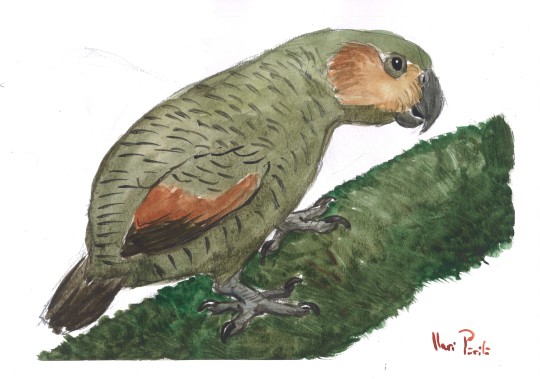
Artwork by @otussketching, written by @zygodactylus
Name Meaning: Unexpected Herculean Parrot
Time: 16 to 19 million years ago (Burdigalian stage of the Miocene epoch, Neogene period)
Location: St. Bathans Fauna, Bannockburn Formation, Aotearoa
Heracles was a truly alarmingly large parrot, related to modern day Kea, Kaka, and Kakapo, known from the fantastic avifauna of St Bathans. Standing more than two feet tall and weighing about fifteen pounds, this animal was much larger than any expected from the St Bathans fauna, which represented the initial colonization of Aotearoa (Zealandia) after it returned above sea level. Heracles is also the largest known species of parrot, ever. It was presumably flightless, though it is uncertain if it was nocturnal like its living relative the Kakapo. Its exact ecology is still uncertain, given the material known from Heracles is limited and its living relatives have very disparate ecologies, though it is possible it was omnivorous similar to the Kea and Kaka today. The St Bathans fauna lived in a freshwater lake system, in a subtropical emergent rainforest. Separated from land bridges, the fauna was dominated by birds, with early relatives of the Kiwi, New Zealand Wrens, Adzebills, and Wedge-Tailed eagles found in the fauna, as well as somewhat modern looking Moas. Smaller flamingos, large fruit pigeons, and a huge variety of geese and other waterfowl are known. In addition, frogs, tuataras, other lizards, crocodilians, turtles, and many different types of fish are known from this fascinating ecosystem.
Heliothraupis oneilli
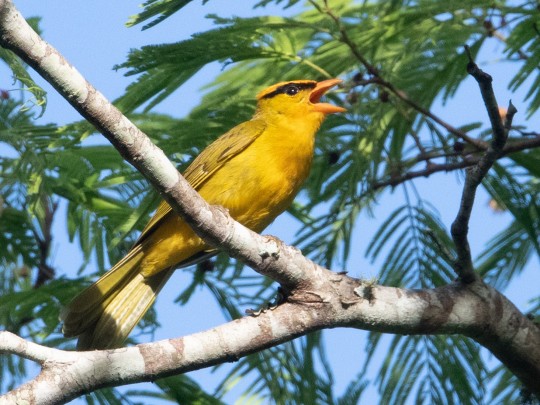
Photograph by John C. Mittermeier, written by @zygodactylus
Name Meaning: O’Neill’s Tanager of the Sun God Inti
Time: Unknown to the present, Holocene, Quaternary
Location: Western Bolivia and Southern Peru, South America
Rarely do we get to talk about a newly discovered living species of bird, but this is one of those excellent times! This bird, a bright yellow tanager with a distinctive black stripe across its eye, was found in the Neotropics - specifically in the Yungas region. Given that Latin America has the largest number of bird species in the world, it makes a certain amount of sense that we may have missed some! First spotted in the nineties, it was properly identified and described over the course of the 2010s. The distinctive appearance of this tanager lead to it being nicknamed the “Kill Bill Tanager”, in reference to its similarity to Uma Thurman’s yellow jumpsuit outfit. Distinct in appearance and population from other tanagers, it was deemed not only a separate species, but an entirely separate genus. It is migratory, breeding in the northern Machariapo Valley and going down to the eastern Andes for the nonbreeding season. It lives in deciduous forests, and breeds in bamboo grasses. It is a loud and vocal bird, making distinctive songs and choruses that happen long after the dawn chorus of most other birds. As it lives in a fairly isolated region of these countries, its habitat is not particularly threatened at this time.
#dmm rising stars#dmm#dinosaur march madness#dinosaurs#palaeoblr#birds#birblr#paleontology#bracket#march madness#polls#heracles#heliothraupis#round two
248 notes
·
View notes
Photo

Origins of giant extinct New Zealand bird traced to Africa
Scientists have revealed the African origins of New Zealand's most mysterious giant flightless bird – the now extinct adzebill – showing that some of its closest living relatives are the pint-sized flufftails from Madagascar and Africa.
Led by the University of Adelaide, the research in the journal Diversity showed that among the closest living relatives of the New Zealand adzebills – which weighed up to 19 kilograms – are the tiny flufftails, which can weigh as little as 25 grams. The closeness of the relationship strongly suggests that the ancestors of the adzebills flew to New Zealand after it became physically isolated from other land.
This finding mirrors the close relationship between New Zealand's kiwi and the extinct Madagascan elephant birds, published by University of Adelaide researchers in 2014, hinting at an unappreciated biological connection between Madagascar and New Zealand.
Like the better-known moa, the two species of adzebill – the North Island adzebill and South Island adzebill –disappeared following the arrival of early Maori in New Zealand, who hunted them and cleared their forest habitats. Unlike the moa, adzebills were predators and not herbivores.
"The adzebill were almost completely wingless and had an enormous reinforced skull and beak, almost like an axe, which is where they got their English name," says Alexander Boast, lead author and former Masters student at the University of Adelaide. "If they hadn't gone extinct, they would be among the largest living birds."
#South Island Adzebill#Aptornis defossor#North Island Adzebill#Aptornis otidiformis#St. Bathans Adzebill#Aptornis proasciarostratus#Aptornis#Aptornithidae#Sarothruridae#Gruiformes#Aves#birds#adzebill#flufftail#ornithology#evolution#extinction#New Zealand
87 notes
·
View notes
Photo


Island Weirdness #35 — Flightless Giants
With the lack of large terrestrial mammals in New Zealand, birds were free to exploit the "big herbivore" niches in the ecosystem — and the giant moa were the ultimate result.
Closely related to modern South American tinamous, the ancestors of moa were small flying birds that arrived in New Zealand sometime in the early Cenozoic. At the time of the Miocene St Bathans fossil deposits they were already large and flightless, and by the Holocene they had grown truly enormous.
Uniquely they completely lost their wings, not even having the tiny vestigial bones seen in other large flightless birds.
The South Island giant moa (Dinornis robustus) was the largest of them all, with females standing almost 2m tall at the back (6'6") and able to reach their heads up to heights of around 3.6m (11'10"). It had a long neck, a relatively tiny head with a curved beak, and large powerful legs — and preserved hair-like body feathers show that it was reddish-brown in color.
It also had some of the most extreme sexual dimorphism seen in any bird species, with the males being significantly smaller than the females at only about 1.2m tall (3'11"). This seems to have been the result of scaling-up smaller differences in body size from their ancestors.

The adzebills were another odd group of big flightless birds whose ancestors also date back to sometime before the St Bathans deposits. They had large downward-curving beaks, short strong legs, and highly reduced wings that were smaller proportionally than those of the dodo.
They were less common than the moa, found only the drier forested parts of the lowlands, and based on isotope analysis of their bones they seem to have been predators hunting invertebrates, reptiles, and smaller birds.
When their remains were first discovered they were even thought to be a type of moa, but later studies (including recovered ancient DNA) have shown they were actually gruiformes, with their closest living relatives being either the South American trumpeters or the African flufftails.
The South Island adzebill (Aptornis defossor) was the slightly larger of the two species known from the Holocene, reaching sizes of about 0.8-1m tall (2'8"-3'3").

The ancestors of the Māori people arrived in New Zealand around the year 1300, and sadly within about a century a combination of human hunting pressure and predation by introduced mammals sent both the moa and adzebills into total extinction.
#science illustration#island weirdness 2019#paleontology#paleoart#palaeoblr#dinornis#moa#palaeognathae#aptornis#adzebill#gruiformes#bird#dinosaur#art#new zealand#island gigantism#holocene extinction#island weirdness 2: endemic boogaloo
156 notes
·
View notes
Text
Fossil find reveals that the world’s largest parrot was over 3 feet tall
About 19 million years ago, the world’s largest parrot lived in New Zealand and used its massive beak to crack open food, according to a new study.
The parrot stood over 3 feet tall and weighed about 15.5 pounds. The fossils were found among others dating to 19 million years ago near St. Bathans in Central Otago, New Zealand. This area is known for its bird fossils dating back to the Miocene period, which ranges between 5.3 and 23 million years ago.
A study describing the bird published Tuesday in the journal Biology Letters.
“New Zealand is well known for its giant birds,” says Trevor Worthy, study author and Flinders University associate professor. “Not only moa dominated avifaunas, but giant geese and adzebills shared the forest floor, while a giant eagle ruled the skies. But until now, no one has ever found an extinct giant parrot – anywhere.”
Researchers have named it Heracles inexpectatus in honor of its Herculean size and strength.
The parrot had a massive beak, which gives rise to questions about its diet.
“Heracles, as the largest parrot ever, no doubt with a massive parrot beak that could crack wide open anything it fancied, may well have dined on more than conventional parrot foods, perhaps even other parrots,” said Mike Archer, study author and professor from the University of New South Wales’ Palaeontology, Geobiology and Earth Archives Research Centre.
“Its rarity in the deposit is something we might expect if it was feeding higher up in the food chain. New Zealand keas, for example, have even developed a taste for sheep since these were introduced by European settlers in 1773.”
When Heracles was alive, it would have been surrounded by laurel and palm trees in a subtropical forest.
“Undoubtedly, these provided a rich harvest of fruit important in the diet of Heracles and the parrots and pigeons it lived with. But on the forest floor Heracles competed with adzebills and the forerunners of moa,” said Suzanne Hand, study author and professor at the University of New South Wales Sydney.
It’s comparable to the giant dodo pigeon found on the Mascarene Islands east of Madagascar and twice the size of the previously known largest parrot, the New Zealand kakapo.
These early parrots were more primitive than ones found in Australia and other areas today.
Now-extinct giant bird species have been associated with islands in the past like the dodo, a giant pigeon found on Fiji, the Flores’ giant stork and Hawaii’s giant ducks.
The St. Bathans fossil deposit also contains the remains of bats, turtles, crocodile ancestors, mammals and more than 40 bird species.
“The St Bathans fauna provides the only insight into the terrestrial birds and other animals that lived in New Zealand since dinosaurs roamed the land more than 66 million years ago,” says Paul Scofield, study author and senior curator at the Canterbury Museum in Christchurch, New Zealand. “This was a very different place with a fauna very unlike that which survived into recent times.”
from FOX 4 Kansas City WDAF-TV | News, Weather, Sports https://fox4kc.com/2019/08/06/fossil-find-reveals-that-the-worlds-largest-parrot-was-over-3-feet-tall/
from Kansas City Happenings https://kansascityhappenings.wordpress.com/2019/08/07/fossil-find-reveals-that-the-worlds-largest-parrot-was-over-3-feet-tall/
1 note
·
View note
Text
Round Four: Vorombe vs Heracles
Vorombe titan
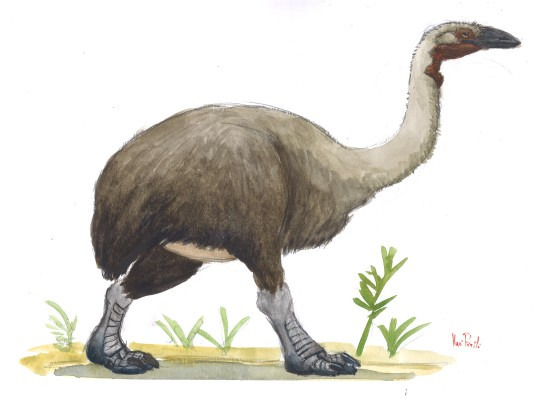
Artwork by @otussketching, written by @zygodactylus
Name Meaning: Titan of the Big Birds
Time: 10,000 years ago to sometime in the past 2000 years (Holocene epoch of the Quaternary period)
Location: Southern Madagascar
Vorombe is a newly erected genus of Elephant Bird, the largest that we know of! Whereas all species of Elephant Bird used to be put in the same genus, distinct differences among the types of Elephant Bird that we know of indicate they deserve their own genus names - and here we are! Vorombe was significantly larger than the other species of Elephant Bird, and probably was about 3 meters (nearly 10 feet) tall when standing. It was also ridiculously heavy, weighing around 650 kilograms. As such, Vorombe is currently the largest known bird ever recorded. It lived in the arid and succulent woodlands as well as the grassland mosaics, the weirdly unique habitats that charactierize Madagascar, and was a major feature in the functioning of those ecosystem - helping to spread plant seeds and maintain habitats as they lived within them. Vorombe and other Elephant Birds lived alongside a lot of weird animals during the Quaternary of Madadgascar, including dwarf hippos, giant tortoises, and giant lemurs.
Note: A paper came out literally on the last day of February this year indicating Vorombe may not be its own genus, and as such, it would not qualify as a "rising star". More work is needed to determine if this bird is distinct from Aepyornis. Please take this into account when voting.
Heracles inexpectatus

Artwork by @otussketching, written by @zygodactylus
Name Meaning: Unexpected Herculean Parrot
Time: 16 to 19 million years ago (Burdigalian stage of the Miocene epoch, Neogene period)
Location: St. Bathans Fauna, Bannockburn Formation, Aotearoa
Heracles was a truly alarmingly large parrot, related to modern day Kea, Kaka, and Kakapo, known from the fantastic avifauna of St Bathans. Standing more than two feet tall and weighing about fifteen pounds, this animal was much larger than any expected from the St Bathans fauna, which represented the initial colonization of Aotearoa (Zealandia) after it returned above sea level. Heracles is also the largest known species of parrot, ever. It was presumably flightless, though it is uncertain if it was nocturnal like its living relative the Kakapo. Its exact ecology is still uncertain, given the material known from Heracles is limited and its living relatives have very disparate ecologies, though it is possible it was omnivorous similar to the Kea and Kaka today. The St Bathans fauna lived in a freshwater lake system, in a subtropical emergent rainforest. Separated from land bridges, the fauna was dominated by birds, with early relatives of the Kiwi, New Zealand Wrens, Adzebills, and Wedge-Tailed eagles found in the fauna, as well as somewhat modern looking Moas. Smaller flamingos, large fruit pigeons, and a huge variety of geese and other waterfowl are known. In addition, frogs, tuataras, other lizards, crocodilians, turtles, and many different types of fish are known from this fascinating ecosystem.
#dmm#dmm rising stars#dinosaur march madness#dinosaurs#birds#palaeoblr#birblr#paleontology#march madness#bracket#polls#round four#heracles#vorombe#avenge annakacygna
148 notes
·
View notes
Text
Round Three: Cryptogyps vs Heracles
Cryptogyps lacertosus

Artwork by @otussketching, written by @zygodactylus
Name Meaning: Powerful Hidden Vulture
Time: 770,000 to 55,000 years ago (Chibanian to Tarantian stage of the Pleistocene epoch, Quaternary period)
Location: Throughout Australia, including Kalamurina, the Wellington Caves, and the Nullarbor Plain
Today, there are no vultures in Australia. In fact, until recently, it seemed fairly clear that no vultures had lived in Australia - but now, we know they did! Originally thought to be an eagle, Cryptogyps was on the small size for a vulture, only bigger than the living Hooded Vulture - though it was about the size of the wedge-tailed eagle. However, it was proportioned similarly to other vultures, and between that and its great range across the entirety of Australia, it is logical to conclude that it lived similarly to other vultures, feeding primarily on carrion and going great distances to find it. It did not have the right musculature to be an active hunter like eagles and hawks. As such, Cryptogyps was a vital part of its environment, reducing the spread of disease and recycling nutrients and energy back into the food web like vultures today. Cryptogyps lived alongside a wide variety of weird megafuana present in Australia during the last ice age, including marsupial lions, giant demon-ducks (mihirungs), giant hippo-sized wombats, sheep-sized and fossorial echidnas, short-faced kangaroos, giant koalas, thylacines, giant maleefowls, huge monitor lizards, large crocodilians, and giant pythons - as well as cassowaries, regular kangaroos, emus, and other large animals that remain today. It was a weird place of which Cryptogyps was a small and important part, and would have been a regular sight in the skies to the first Indigenous Australians to settle on the continent!
Heracles inexpectatus
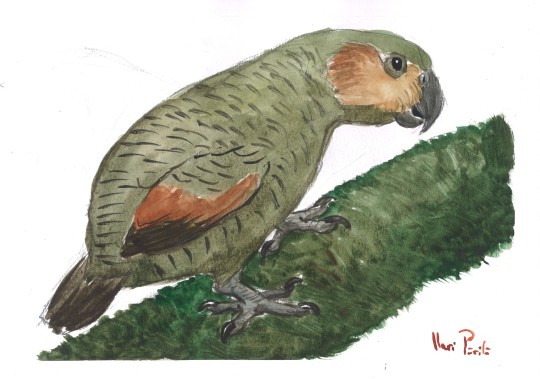
Artwork by @otussketching, written by @zygodactylus
Name Meaning: Unexpected Herculean Parrot
Time: 16 to 19 million years ago (Burdigalian stage of the Miocene epoch, Neogene period)
Location: St. Bathans Fauna, Bannockburn Formation, Aotearoa
Heracles was a truly alarmingly large parrot, related to modern day Kea, Kaka, and Kakapo, known from the fantastic avifauna of St Bathans. Standing more than two feet tall and weighing about fifteen pounds, this animal was much larger than any expected from the St Bathans fauna, which represented the initial colonization of Aotearoa (Zealandia) after it returned above sea level. Heracles is also the largest known species of parrot, ever. It was presumably flightless, though it is uncertain if it was nocturnal like its living relative the Kakapo. Its exact ecology is still uncertain, given the material known from Heracles is limited and its living relatives have very disparate ecologies, though it is possible it was omnivorous similar to the Kea and Kaka today. The St Bathans fauna lived in a freshwater lake system, in a subtropical emergent rainforest. Separated from land bridges, the fauna was dominated by birds, with early relatives of the Kiwi, New Zealand Wrens, Adzebills, and Wedge-Tailed eagles found in the fauna, as well as somewhat modern looking Moas. Smaller flamingos, large fruit pigeons, and a huge variety of geese and other waterfowl are known. In addition, frogs, tuataras, other lizards, crocodilians, turtles, and many different types of fish are known from this fascinating ecosystem.
#dmm#dmm rising stars#dinosaur march madness#dinosaurs#birds#paleontology#birblr#palaeoblr#march madness#bracket#polls#round three#cryptogyps#heracles
175 notes
·
View notes
Text
Danielsraptor vs Heracles
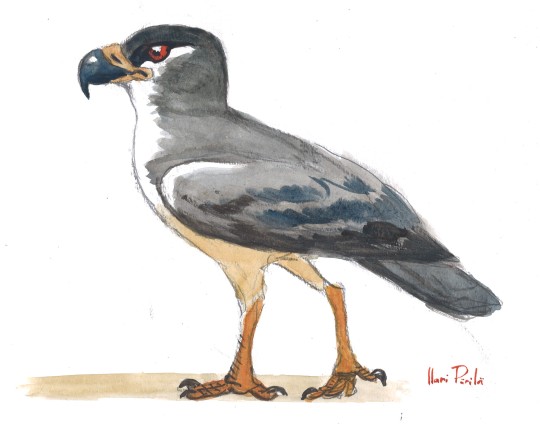

Factfiles:
Danielsraptor phorusrhacoides

Artwork by @otussketching, written by @zygodactylus
Name Meaning: Michael Daniels’ Terror Thief Bird
Time: 55 million years ago (Ypresian stage of the Eocene epoch, Paleogene period)
Location: Walton Member, London Clay Formation, England
While the Eocene fossil records of Seriemas, Passerines, and Parrots are fairly well known, the last remaining group of Australavians - the Falcons - remains something of a mystery. Danielsraptor helps to put together this puzzle a little more. Along with Masillaraptor, these birds show an early radiation of falcon-relatives from the Eocene in which they tried out a more terrestrial lifestyle! Danielsraptor had long legs, allowing it to forage and hunt on the ground like modern caracaras. It had a very large pygostyle, giving it long tail feathers - and with strong wing bones, it was able to fly in addition to hunt on the ground. It had a beak very similar to living caracaras and the extinct Terror Birds, further corroborating the idea that it was a bird of prey (and also potentially indicating a more complex evolutionary story for the early-derived Australavians). Living in the London Clay, Danielsraptor would have been one of the top predators, easily hunting the small mammals as well as the birds it shared its environment with - aided by both its terrestrial stalking abilities as well as its flying capability. Living in the London Clay, it shared its environment with the early loon Nasidytes, early owls, trogons, paleognaths, tropicbirds, duck-screamers, other diurnal raptors, the pseudotoothed bird Dasornis, and many parrot-passerine relatives. Crocodilians, snakes, turtles, fish, sharks, and a handful of mammals (including a primate) also lived in this rich post-Paleocene-Eocene Thermal Maximum environment.
Heracles inexpectatus

Artwork by @otussketching, written by @zygodactylus
Name Meaning: Unexpected Herculean Parrot
Time: 16 to 19 million years ago (Burdigalian stage of the Miocene epoch, Neogene period)
Location: St. Bathans Fauna, Bannockburn Formation, Aotearoa
Heracles was a truly alarmingly large parrot, related to modern day Kea, Kaka, and Kakapo, known from the fantastic avifauna of St Bathans. Standing more than two feet tall and weighing about fifteen pounds, this animal was much larger than any expected from the St Bathans fauna, which represented the initial colonization of Aotearoa (Zealandia) after it returned above sea level. Heracles is also the largest known species of parrot, ever. It was presumably flightless, though it is uncertain if it was nocturnal like its living relative the Kakapo. Its exact ecology is still uncertain, given the material known from Heracles is limited and its living relatives have very disparate ecologies, though it is possible it was omnivorous similar to the Kea and Kaka today. The St Bathans fauna lived in a freshwater lake system, in a subtropical emergent rainforest. Separated from land bridges, the fauna was dominated by birds, with early relatives of the Kiwi, New Zealand Wrens, Adzebills, and Wedge-Tailed eagles found in the fauna, as well as somewhat modern looking Moas. Smaller flamingos, large fruit pigeons, and a huge variety of geese and other waterfowl are known. In addition, frogs, tuataras, other lizards, crocodilians, turtles, and many different types of fish are known from this fascinating ecosystem.
DMM Round One Masterpost
#dmm#dinosaur march madness#dmm round one#dmm rising stars#palaeoblr#dinosaurs#paleontology#bracket#march madness#danielsraptor#heracles#polls
178 notes
·
View notes
Text
Heracles inexpectatus
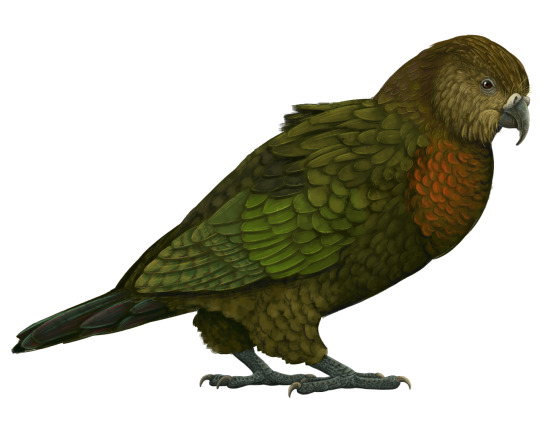
By Scott Reid
Etymology: For the Greek Demigod Heracles
First Described By: Worthy et al., 2019
Classification: Dinosauromorpha, Dinosauriformes, Dracohors, Dinosauria, Saurischia, Eusaurischia, Theropoda, Neotheropoda, Averostra, Tetanurae, Orionides, Avetheropoda, Coelurosauria, Tyrannoraptora, Maniraptoromorpha, Maniraptoriformes, Maniraptora, Pennaraptora, Paraves, Eumaniraptora, Averaptora, Avialae, Euavialae, Avebrevicauda, Pygostaylia, Ornithothoraces, Euornithes, Ornithuromorpha, Ornithurae, Neornithes, Neognathae, Neoaves, Inopinaves, Telluraves, Australaves, Eufalconimorphae, Psittacopasserae, Psittaciformes, Strigopoidea
Status: Extinct
Time and Place: Between 19 and 16 million years ago, in the Burdigalian of the Miocene

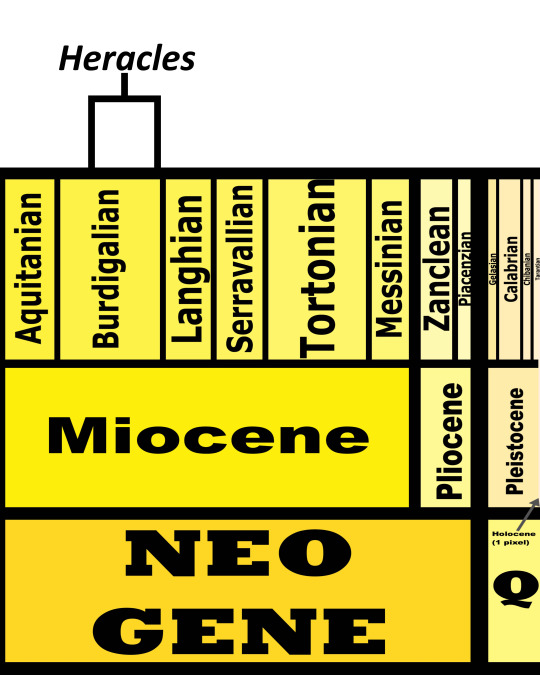
Heracles is known from the Bannockburn Formation of the South Island of New Zealand
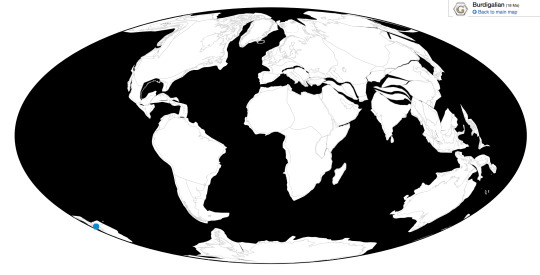
Physical Description: Heracles is an utterly fascinating recent dinosaur discovery, both for its inherent qualities and those due to the circumstances of its discovery. This was a large, Kākāpō-like parrot, about the height of a shorter adult or a child. It is the largest known parrot, and it would have been about one meter tall and weighing about seven kilograms. Given this size, it was flightless, and probably mostly terrestrial. It had a very strong beak, and probably resembled in many ways a giant version of the modern-day Kākāpō, Kaka, and Kea. As such, it would have been quite fat looking, probably greenish in color, and very fluffy as well.

By Brian Choo, Press Release Image
Diet: As a parrot, Heracles is most likely to have fed on seeds and nuts, though the fact that it was closely related to the living Kea means there is a non insignificant chance it was carnivorous. For now, we’ll say it was most likely an omnivore.
Behavior: It is logical to presume that Heracles resembled its modern relatives, which means it would have been a loosely social animal, spending most of its time on the ground in groups of about a dozen animals. It would have been able to use tools to get at sources of food, especially difficult to reach ones. It possibly would have also used its sharp beak to attack other dinosaurs on the island, chasing them with a hopping gait until they were isolated and then killed. An intelligent animal, it would have been able to solve puzzles and work together to get at sources of food or shelter. As a member of the New Zealand Parrot Group, it probably would have been polygamous, with the males having multiple mates at a time. They would have made nests on the ground, and since they never came across with mammalian predators, they probably would have been fine in terms of reproduction rate.

By Ripley Cook
Ecosystem: The Saint Bathans Fauna was a unique ecosystem filled with almost entirely birds, and other creatures that could float or fly over to New Zealand after it emerged from having flooded. This meant that birds were filling niches that, in the rest of the world, were being taken up by mammals. In short, this was a weird sort of Jurassic Park - with dinosaurs wreaking havoc as echoes of their former reign. Dinosaurs of the Saint Bathans Fauna included another New Zealand Parrot, Nelepsittacus, a bittern Pikaihao, herons like Matuku and Pikaihao, the swimming flamingo Palaelodus, flightless rails such as Priscaweka and Litorallus, the early Adzebill Aptornis proasciarostratus, the pigeon Rupephaps, the stiff-tailed duck Dunstanneta, the early Kiwi Proapteryx, the small Manuherikia duck, and the early New Zealand Wren Kuiornis - just to name a few! Given that only sparse remains are known from some unnamed birds of prey, this points to Heracles being at least somewhat carnivorous and fulfilling that role in its ecosystem. This was a series of extensive lakes, filled with cycad and palm trees, and there were also a wide variety of geckos, skinks, crocodilians, turtles, tuatara, and bats. There was one other mammal present - but, for now, we have no idea what it was.

By José Carlos Cortés
Other: The Saint Bathans Fauna is one of the most fascinating ecosystems of fossil birds of the Cenozoic Era. The unique ecosystem of New Zealand, with its almost complete lack of mammals before human interference. Heracles is an extremely important fossil find, as it may help us to piece together how the weird New Zealand Parrots evolved - previously, little was known in the way of fossil members of this group beyond recent history. The more we research it, the more we will be able to understand one small piece of the evolutionary puzzle that is this unique island. Also, it’s common name is Squawkzilla.
~ By Meig Dickson
Sources Under the Cut
Mather, Ellen K.; Tennyson, Alan J. D.; Scofield, R. Paul; Pietri, Vanesa L. De; Hand, Suzanne J.; Archer, Michael; Handley, Warren D.; Worthy, Trevor H. (2019-03-04). “Flightless rails (Aves: Rallidae) from the early Miocene St Bathans Fauna, Otago, New Zealand”. Journal of Systematic Palaeontology. 17 (5): 423–449.
Scofield, R. Paul; Worthy, Trevor H. & Tennyson, Alan J.D. (2010). “A heron (Aves: Ardeidae) from the Early Miocene St Bathans Fauna of southern New Zealand.” (PDF). In W.E. Boles & T.H. Worthy. (eds.). Proceedings of the VII International Meeting of the Society of Avian Paleontology and Evolution. Records of the Australian Museum. 62. pp. 89–104.
Tennyson, Alan J. D.; Worthy, Trevor H.; Scofield, R. Paul (2010). “A heron (Aves: Ardeidae) from the Early Miocene St Bathans fauna of southern New Zealand. In Proceedings of the VII International Meeting of the Society of Avian Paleontology and Evolution, ed. W.E. Boles and T.H. Worthy”. Records of the Australian Museum. 62: 89–104.
Worthy, Trevor H.; Lee, Michael S. Y. (2008). “Affinities of Miocene Waterfowl (anatidae: Manuherikia, Dunstanetta and Miotadorna) from the St Bathans Fauna, New Zealand”. Palaeontology. 51 (3): 677–708.
Worthy, Trevor H.; Tennyson, Alan J. D.; Hand, Suzanne J.; Scofield, R. Paul (2008-06-01). “A new species of the diving duck Manuherikia and evidence for geese (Aves: Anatidae: Anserinae) in the St Bathans Fauna (Early Miocene), New Zealand”. Journal of the Royal Society of New Zealand. 38 (2): 97–114.
Worthy, T. H., S. J. Hand, M. Archer, R. P. Scofield, and V. L. De Pietri. 2019. Evidence for a giant parrot from the Early Miocene of New Zealand. Biology Letters 15:20190467
#Heracles#heracles inexpectatus#Parrot#New Zealand Parrot#Dinosaur#Dinosaurs#Birds#Bird#palaeoblr#birblr#psittaciformes#Australavian#factfile#Terrestrial Tuesday#Omnivore#Australia & Oceania#Neogene
248 notes
·
View notes
Text
Kuiornis indicator

By Ripley Cook
Etymology: The Demigod Kui’s Bird
First Described By: Worthy et al., 2010
Classification: Dinosauromorpha, Dinosauriformes, Dracohors, Dinosauria, Saurischia, Eusaurischia, Theropoda, Neotheropoda, Averostra, Tetanurae, Orionides, Avetheropoda, Coelurosauria, Tyrannoraptora, Maniraptoriformes, Maniraptora, Pennaraptora, Paraves, Eumaniraptora, Averaptora, Avialae, Euavialae, Avebrevicauda, Pygostylia, Ornithothoraces, Euornithes, Ornithuromorpha, Ornithurae, Neornithes, Neognathae, Neoaves, Australaves, Psittacopasserae, Passeriformes, Acanthisitti, Acanthisittidae
Status: Extinct
Time and Place: Between 19 and 16 million years ago, in the Burdigalian of the Miocene


Kuiornis is from the Saint Bathans Fauna, a distinctive snapshot of the evolution of New Zealand’s unique birds - from the Bannockburn Formation of the South Island of New Zealand
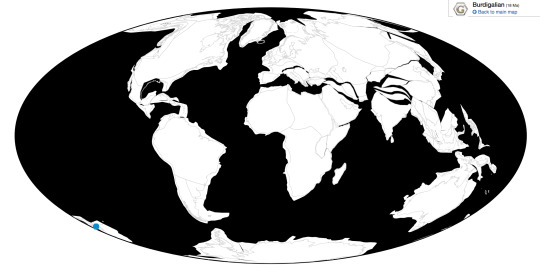
Physical Description: Kuiornis is known from limb elements, so we don’t know much about it, but it seems to have been only a little smaller than the living Rifleman, its closest relative - so it was probably around 7 centimeters long. It would have looked similar to the living Rifleman as well - a round bird, with a distinctively thin tail, and a small head with a triangular beak. As for differences from living New Zealand Wrens, it had differently formed and more compact legs. Beyond this, it’s difficult to say more about the specific appearance of Kuiornis; it probably would have been green and brown in color, like its living relatives.
Diet: Without fossil evidence of the beak, we have to assume that Kuiornis was an omnivore; given that New Zealand Wrens today favor invertebrates but still eat other forms of food, this is not an unreasonable assumption.
Behavior: Kuiornis would have been very skittish like modern New Zealand Wrens, flitting back and forth between the shrubs and vegetation in its habitat. It would have probably been only moderately social, like living New Zealand Wrens, and making high pitched, non-musical calls. Kuiornis would then spend most of its time foraging for food. When not doing that, it would have taken care of its young, building nests out of grass and in secluded spaces. It is difficult to say much about its breeding behavior - or behavior in general - however, since very little is known from this dinosaur.
Ecosystem: At the end of the Paleogene, New Zealand flooded. This completely erased the previous ecosystem, killing most things that had been on the island before that point. Afterwards, the only things that were able to colonize the space were creatures that floated over, and creatures that could fly. This included lizards and snakes and other reptiles, bats, and most notably of all - birds. New Zealand had one of the most unique avifaunas of all time, with many birds evolving to fill roles that mammals took in other locations - things like the moas, the large birds of prey, the adzebills, and living forms like the New Zealand Parrots that are like avian rodents and rabbits. The Saint Bathans Fauna is a snapshot of that initial colonization, showing how these unique birds began to diversify after New Zealand reemerged, in a lush lake enviroment. Kuiornis is just one part of that - showing the origin of the weird New Zealand Wrens. There was also the early Kiwi Proapteryx, the small Manuherikia ducks, the stiff-tailed Dunstanneta, the shelduck Miotadorna, the goose Cereopsis, the wood duck Matanas, the weird pigeon Rupephaps, the early Adzebill Aptornis proasciarostratus, the flightless rails Priscaweka and Litorallus, the swimming flamingo Palaelodus, the herons Matuku and Pikaihao, the bittern Pikaihao, the New Zealand Parrot Nelepsittacus, and potential eagles and hawks. There were also many geckos, skinks, crocodilians, turtles, and tuatara present as well. Weirdly enough, there was a mammal other than bats - but that mammal is what we would call a Mystery.
Other: Kuiornis has been extensively studied in phylogenetic analyses, and these analyses consistently recover Kuiornis as a New Zealand Wren, so it is an important find in understanding how this unique group of little dinosaurs evolved in such an isolated environment as New Zealand. Interestingly enough, it consistently comes out as very much nested in the group, extremely closely related to the Rifleman. This indicates that Kuiornis is not a decent model for the ancestor of the New Zealand Wrens, and also that advanced members of this group were present as recent as the mid-Neogene period.
~ By Meig Dickson
Sources under the Cut
Archer, Michael; Boles, Walter E.; Scofield, R. Paul; Worthy, Jennifer P.; Tennyson, Alan J. D.; Nguyen, Jacqueline M. T.; Hand, Suzanne J.; Worthy, Trevor H. (2010). "Biogeographical and Phylogenetic Implications of an Early Miocene Wren (Aves: Passeriformes: Acanthisittidae) from New Zealand". Journal of Vertebrate Paleontology. 30 (2): 479–498.
England, R. 2013. Recent advances in avian palaeobiology in New Zealand with implications for understanding New Zealand’s geological, climatic and evolutionary histories. Masters of Science Thesis, Massey University, Palmerston North, New Zealand.
Hand, SJ; Worthy, Trevor H.; Archer, M; Worthy, JP; Tennyson, AJD; Scofield, RP (2013). "Miocene mystacinids (Chiroptera, Noctilionoidea) indicate a long history for endemic bats in New Zealand". Journal of Vertebrate Paleontology 33 (6): 1442-1448.
Hand, Suzanne J.; Lee, Daphne E.; Worthy, Trevor H.; Archer, Michael; Worthy, Jennifer P.; Tennyson, Alan J. D.; Salisbury, Steven W.; Scofield, R. Paul; Mildenhall, Dallas C. (2015). "Miocene Fossils Reveal Ancient Roots for New Zealand's Endemic Mystacina (Chiroptera) and its Rainforest Habitat". PLoS ONE. 10 (6): e0128871.
Jones MEH; Tennyson AJD; Worthy JP; Evans SE; Worthy TH (2009). "A sphenodontine (Rhynchocephalia) from the Miocene of New Zealand and palaeobiogeography of the tuatara (Sphenodon)". Proceedings of the Royal Society B. 276 (1660): 1385–1390.
Mather, Ellen K.; Tennyson, Alan J. D.; Scofield, R. Paul; Pietri, Vanesa L. De; Hand, Suzanne J.; Archer, Michael; Handley, Warren D.; Worthy, Trevor H. (2019-03-04). "Flightless rails (Aves: Rallidae) from the early Miocene St Bathans Fauna, Otago, New Zealand". Journal of Systematic Palaeontology. 17 (5): 423–449.
Michael S. Y. L.; Hutchinson Mark N.; Worthy Trevor H.; Archer Michael; Tennyson Alan J. D.; Worthy Jennifer P.; Scofield R. Paul (2009-12-23). "Miocene skinks and geckos reveal long-term conservatism of New Zealand's lizard fauna". Biology Letters. 5 (6): 833–837.
Mitchell, K. J., J. R. Wood, B. Llamas, P. A. McLenachan, O. Kardailsky, R. P. Scofield, T. H. Worthy, A. Cooper. 2016. Ancient mitochondrial genomes clarify the evolutionary history of New Zealand’s enigmatic acanthisittid wrens. Molecular Phylogenetics and Evolution: 1 - 29.
Schwarzhans, Werner; Scofield, R. Paul; Tennyson, Alan J.D.; Worthy, Jennifer P.; Worthy, Trevor H. (2012). "Fish Remains, Mostly Otoliths, from the Non-Marine Early Miocene of Otago, New Zealand". Acta Palaeontologica Polonica. 57 (2): 319–350.
Scofield, R. Paul; Worthy, Trevor H. & Tennyson, Alan J.D. (2010). "A heron (Aves: Ardeidae) from the Early Miocene St Bathans Fauna of southern New Zealand." (PDF). In W.E. Boles & T.H. Worthy. (eds.). Proceedings of the VII International Meeting of the Society of Avian Paleontology and Evolution. Records of the Australian Museum. 62. pp. 89–104.
Scofield, R. Paul; Hand, Suzanne J.; Salisbury, Steven W.; Tennyson, Alan J. D.; Worthy, Jennifer P.; Worthy, Trevor (2013). "Miocene fossils show that kiwi (Apteryx, Apterygidae) are probably not phyletic dwarves". Paleornithological Research 2013 – Proceedings of the 8th International Meeting of the Society of Avian Paleontology and Evolution: 63–80.
Tennyson, Alan J. D.; Worthy, Trevor H.; Scofield, R. Paul (2010). "A heron (Aves: Ardeidae) from the Early Miocene St Bathans fauna of southern New Zealand. In Proceedings of the VII International Meeting of the Society of Avian Paleontology and Evolution, ed. W.E. Boles and T.H. Worthy". Records of the Australian Museum. 62: 89–104.
Tennyson, Alan J.D., Worthy, Trevor H., Jones, Craig M., Scofield, R. Paul & Hand, Suzanne J. (2010). "Moa's Ark: Miocene fossils reveal the great antiquity of moa (Aves: Dinornithiformes) in Zealandia". Records of the Australian Museum, 62 (1): 105–114.
Worthy, Trevor H.; Tennyson, Alan J. D.; Archer, Michael; Musser, A. M.; Hand, S. J.; Jones, C.; Douglas, B. J.; McNamara, J. A.; Beck, R. M. D. (2006). "Miocene mammal reveals a Mesozoic ghost lineage on insular New Zealand, southwest Pacific". Proceedings of the National Academy of Sciences. 103 (51): 19419–19423.
Worthy, Trevor H.; Tennyson, Alan J. D.; Jones, C.; McNamara, J. A.; Douglas, B. J. (2007). "Miocene waterfowl and other birds from central Otago, New Zealand". Journal of Systematic Palaeontology. 5 (1): 1–39.
Worthy, Trevor H.; Lee, Michael S. Y. (2008). "Affinities of Miocene Waterfowl (anatidae: Manuherikia, Dunstanetta and Miotadorna) from the St Bathans Fauna, New Zealand". Palaeontology. 51 (3): 677–708.
Worthy, Trevor H.; Tennyson, Alan J. D.; Hand, Suzanne J.; Scofield, R. Paul (2008-06-01). "A new species of the diving duck Manuherikia and evidence for geese (Aves: Anatidae: Anserinae) in the St Bathans Fauna (Early Miocene), New Zealand". Journal of the Royal Society of New Zealand. 38 (2): 97–114.
Worthy, Trevor H.; Tennyson, Alan J. D.; Archer, Michael; Scofield, R. Paul (2010). Boles, Walter E.; Worthy, Trevor H. (eds.). "First record of Palaelodus (Aves: Phoenicopteriformes) from New Zealand". Proceedings of the VII International Meeting of the Society of Avian Paleontology and Evolution; Records of the Australian Museum. 62 (1): 77–88.
Worthy, T. H., S. J. Hand, J. M. T. Nguyen, A. J. D. Tennyson, J. P. Worthy, R. P. Scofield, W. E. Boles, M. Archer. 2010. Biogeographical and Phylogenetic Implications of an Early Miocene Wren (Aves: Passeriformes: Acanthisittidae) from New Zealand. Journal of Vertebrate Paleontology 30 (2): 479 - 498.
Worthy, Trevor H.; Tennyson, Alan J. D.; Hand, Suzanne J.; Godthelp, Henk; Scofield, R. Paul (2011). "Terrestrial Turtle Fossils from New Zealand Refloat Moa's Ark". Copeia. 2011 (1): 72–76.
Worthy, Trevor H.; Tennyson, Alan J. D.; Scofield, R. Paul (2011-07-01). "Fossils reveal an early Miocene presence of the aberrant gruiform Aves: Aptornithidae in New Zealand". Journal of Ornithology. 152 (3): 669–680.
Worthy, Trevor H.; Tennyson, Alan J. D.; Scofield, R. Paul (2011). "An early Miocene diversity of parrots (Aves, Strigopidae, Nestorinae) from New Zealand". Journal of Vertebrate Paleontology. 31 (5): 1102–1116.
Worthy, T. H.; Tennyson, A. J. D.; Scofield, R. P.; Hand, S. J. (2013-12-01). "Early Miocene fossil frogs (Anura: Leiopelmatidae) from New Zealand". Journal of the Royal Society of New Zealand. 43 (4): 211–230.
Worthy, T. H., V. L. De Pietri, R. P. Scofield. 2017. Recent advances in avian palaeobiology in New Zealand with implications for understanding New Zealand’s geological, climatic and evolutionary histories. New Zealand Journal of Zoology 44 (3): 177 - 211.
Worthy, Trevor H.; Salisbury, Steven W.; Pietri, Vanesa L. De; Tennyson, Alan J. D.; R. Paul Scofield; Gunnell, Gregg F.; Simmons, Nancy B.; Archer, Michael; Beck, Robin M. D. (2018-01-10). "A new, large-bodied omnivorous bat (Noctilionoidea: Mystacinidae) reveals lost morphological and ecological diversity since the Miocene in New Zealand". Scientific Reports. 8 (1): 235.
#Kuiornis indicator#Kuiornis#Bird#Dinosaur#New Zealand Wren#Perching Bird#Passeriform#Birds#Dinosaurs#Palaeoblr#Birblr#Factfile#Omnivore#Songbird Saturday & Sunday#Australia & Oceania#Neogene#paleontology#prehistory#prehistoric life#biology#a dinosaur a day#a-dinosaur-a-day#dinosaur of the day#dinosaur-of-the-day#science#nature
156 notes
·
View notes